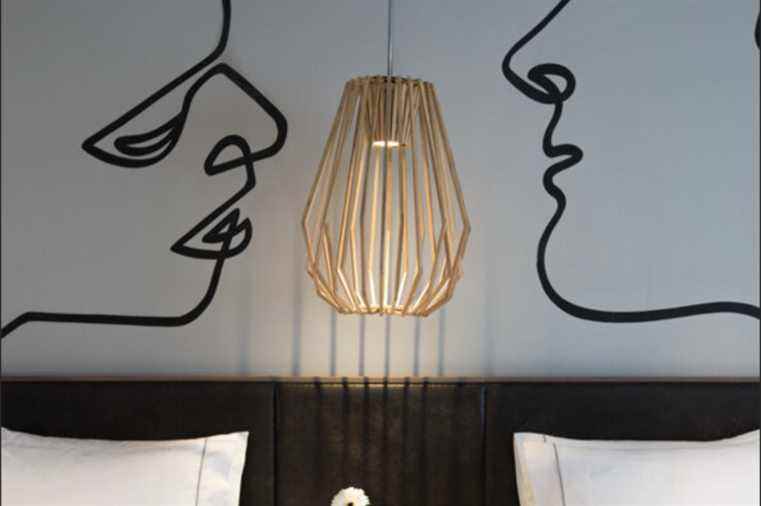Certain elements pass or break in the impression left on the visitor during his stay at the hotel: a lack of cleanliness or comfort, poor ergonomics or a lack of amenities are not forgiving. For these reasons, before reproducing rooms in tens or hundreds of copies, large-scale hotel projects first recreate the decor in a sample room which will be analyzed in detail.
A successful hotel room must meet the needs of the clientele and have no source of irritation: are the rolling of the chairs, the soundproofing, the storage adequate? These are all questions to which designers will have to answer in the affirmative, while respecting the detailed specifications provided by the brands. In addition, there are essential practical considerations such as ease of maintenance and respect for the budget.
“The hotel business is attention to detail. Everything must be controlled, ”sums up designer Louise Dupont, who has worked with Groupe Germain for 25 years. But once the basic criteria have been checked, this ensures that the stay appeals to customers or not is expressed elsewhere.
Stand out from the crowd

PHOTO STEPHANE BRUGGER, SUPPLIED BY SID LEE
The expected configurations must be revisited to create the surprise, believes Martin Leblanc, who worked on the decor of the rooms of the W in Montreal.
“What insults me as a client is the lack of imagination and surprises,” notes Martin Leblanc, architect and senior partner at Sid Lee, who has worked in particular on the design of the W hotels in Montreal and Toronto. and the renovation of the new Fairmont The Queen Elizabeth. “We often work in expected configurations, but we work very hard to break the mold. ”
Artisans in the hotel trade are ruthless customers, agrees Louise Dupont, who hates fittings designed “just for the sake of the weather”. “I like people telling me a story through the setting,” says the senior partner of Lemay Michaud’s Montreal office. “And to get there, there are no limits. If it takes aluminum foil on the walls to give a lunar atmosphere, why not! ”
When Le Germain de Montréal was created, his firm studied the past of the building that was once the seat of the Order of Engineers of Quebec. The year of its construction – 1967 – was decisive for Montreal, but also for the world of design, which saw its field of possibilities increase with the industrialization of plastic. The narrative framework was targeted: the decor made multiple winks at the time. “It is this kind of framework that gives meaning to the layout and ensures that an establishment stands out and that people want to go there. “

PHOTO PROVIDED BY LEMAY MICHAUD
A round bed installed in some rooms at Germain Montreal is a nod to the past of the building erected in 1967. This is also the case with the bubble chair, an iconic and “instagramable” object that makes people talk.
“It is important that it is not just a commercial design, but that it is narrative, corroborates Martin Leblanc. To have value and relevance, a decor must relate to its environment. »It is in the story that she tells that the room connects with the overall identity of the hotel, itself set in a context. “Most brands want to offer a local connection, but sometimes we also try to make locals travel. ”
A change of scenery

PHOTO PROVIDED BY LEMAY MICHAUD
In the Germain rooms, a mural takes up certain artefacts from Montreal from 1967.
“Telling a story, selling ideas: this is the role of the designer in a hotel context”, also notes the artistic director Andrès Escobar, who notably signed the development of Humaniti, in Montreal, and of several new hotels. Yorker with his firm Lemay Escobar. “What appeals to a one-night stand, like a yellow sofa, doesn’t always appeal to your home, but it’s a fleeting way of transporting yourself. “

PHOTO PROVIDED BY LEMAY ESCOBAR
Natural woods and a balanced, comforting color palette are complemented by a few energetic touches of yellow.
All the senses must be engaged, adds the designer, and this pleasure must be consistent and omnipresent throughout the experience. The architect Philip Hazan, who designed the rooms at the Four Seasons in Montreal in collaboration with the Gilles et Boisier agency, also agrees. “The senses must be challenged, from the reflection of the mirrors to the softness of the velvet, the comfort of the bed, the appeal of the bar and the taste of the cocktails offered to the rooms. Until the smell that subtly comes to us and immediately puts us at ease. “

PHOTO PROVIDED BY THE FOUR SEASONS MONTREAL
Bathed in light, the bathroom in this room at the Four Seasons in Montreal automatically evokes luxury.
The success of a concept is to create a space that the guest immediately feels luxurious. And this luxury is not associated with objects, but rather with the emotions that one feels in the presence of these objects.
Philip Hazan, designer of the Four Seasons in Montreal

PHOTO PROVIDED BY THE FOUR SEASONS MONTREAL
The softness of a velvet, like the smells, appeal to the senses in this room at the Four Seasons in Montreal.
We try to bring to life an emotion and a comfort that comes out of everyday life. On the other hand, the atmosphere must be enveloping like at home, underlines Pierre Brousseau, director of Camdi design, which has created several hotel decors, including those of the Capitol, in Quebec, and of the Place d’Armes, in Montreal. “The trend is towards a very ‘homy’ design. Moreover, we now work a lot with deposited furniture [plutôt qu’intégré], which gives a warmer decor. ”
“A hotel room must do three things: be ergonomic, reassure and surprise”, summarizes Martin Leblanc. And that’s why the decor will always be one step ahead of residential trends: it must take us on a journey outside of everyday life.

